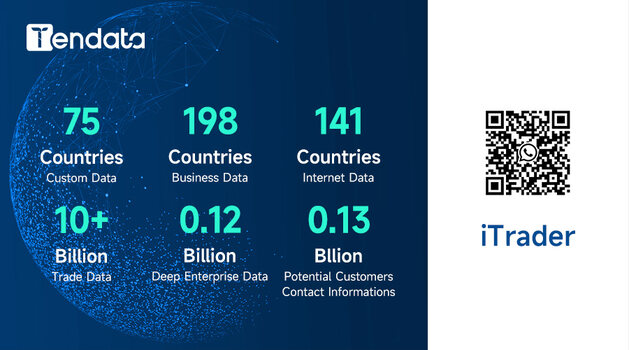 Trade Data Provider
Trade Data Provider
 2023-10-23
2023-10-23
In the complex web of global trade, the role of import and export data
companies has become crucial. These companies provide valuable information to
businesses, aiding them in strategy formulation, market opportunity
identification, and risk mitigation. However, there are numerous import and
export data companies in the market, each offering different levels of
cost-effectiveness. This article will guide you on how to compare the
cost-effectiveness of import and export data companies to ensure that your
chosen partner provides the maximum value, while considering Tendata's pricing
competitiveness.

Defining Tendata Price
Tendata Price refers to the ratio of the price paid for a certain level of performance or effectiveness. In the realm of import and export data, Tendata Price implies that the cost you pay for market insights, competitive intelligence, and trade opportunities relative to the value you receive. A higher Tendata Price indicates that you receive more value, while a lower Tendata Price might suggest you are paying disproportionate fees.
Step One: Clarify Your Needs
To compare the cost-effectiveness of different import and export data companies, start by clearly defining your needs. Various businesses may require different types of data, such as market trends, competitive intelligence, tariff information, etc. Determining your needs will help you choose the right data provider, while considering whether Tendata's pricing aligns with your budget.
Step Two: Evaluate Data Quality
Data quality is a crucial factor in import and export data. Different data providers may use different data sources and collection methods, leading to variations in data accuracy and completeness. To compare the cost-effectiveness, you need to assess the quality of data offered by different companies. Consider the following factors:
· Data Accuracy: Does the data accurately reflect real-world conditions? Are there any errors or omissions?
· Data Timeliness: Is the data regularly updated to reflect market changes?
· Data Coverage: Does the data cover the markets and regions you are concerned with?
Step Three: Assess Data Variety
Apart from data quality, diversity is also essential. Different businesses may require various data types, including import and export data, tariff data, trade partner information, and more. When comparing the cost-effectiveness of data providers, ensure that they can provide the diversity you need to meet your comprehensive information requirements.
Step Four: Understand Data Analysis Tools
Import and export data can be vast and complex, necessitating data analysis tools. When comparing data providers, consider whether they offer user-friendly data analysis tools. These tools should help you quickly extract valuable information, visualize data, generate reports, and perform advanced analysis. Understand Tendata Price policies to determine whether data analysis tools are included.
Step Five: Consider Customer Support
Customer support is also a key factor in cost-effectiveness. Ensure that data providers offer timely, friendly customer support. In case you encounter issues while using data or analysis tools, you should be able to receive prompt assistance and guidance. Familiarize yourself with Tendata's customer support policies to ensure that you can receive support when needed.
Step Six: Compare Prices
Finally, when comparing the cost-effectiveness of different data providers, do not overlook pricing. Different companies have varying price structures, which may include subscription fees, usage fees, customization costs, and more. When comparing prices, ensure that you comprehensively consider data quality, diversity, and analysis tools. Understand Tendata Price competitiveness to determine if it aligns with your budget.
Tendata's Cost-Effectiveness
When considering the cost-effectiveness of different import and export data companies, do not underestimate Tendata. As a market leader, Tendata offers high-quality import and export data that covers global markets and regions. We prioritize data accuracy and timeliness, ensuring that clients always have access to the latest and most reliable information.
Additionally, Tendata provides a variety of data types, including import and export data, tariff data, trade partner information, and more, to meet clients' diverse needs. Our data analysis tools are user-friendly, helping clients better understand and utilize the data. Understand Tendata Price; we are committed to providing high-quality data and services, ensuring clients receive maximum value.
Customer support is one of our key focus areas. We offer round-the-clock support to ensure that clients can receive timely assistance when using our data and tools. Understand Tendata Price policies; we believe it is our responsibility to provide excellent cost-effectiveness. We offer various pricing options to meet the needs of clients across different scales and industries.
When comparing the cost-effectiveness of import and export data companies, do not overlook Tendata. We are dedicated to providing high-quality data and services, ensuring that clients receive maximum value. Choose Tendata for excellent cost-effectiveness, while considering Tendata Price competitiveness.
The criteria for businesses to develop clients can be measured from the following data dimensions: purchase volume, profit margin, payment terms, product style and quality alignment, long-term purchasing stability, loyalty, purchasing potential, communicative guidance intensity, local brand influence, risk resilience, corporate credit rating, and more. Gathering sufficient high-quality customer data and creating accurate customer "profiles" have become the undisputed choice to shift from a passive to an active approach in client development. (>>>Click to Apply for a Free Trial<<<)

With a precise customer "profile" in place, the next step is to proactively analyze and identify their needs. Developing clients can adhere to the "5W+1H" principle: What (what does the customer want to purchase), Why (why do they want to make the purchase), When (when do they plan to make the purchase), Where (from where do they intend to purchase), Who (who makes the final purchasing decision), and How much (what is the budget for the purchase). By addressing these six points with corresponding questions and gradually progressing in the communication process, you can then formulate market and pricing strategies, minimizing decision errors. (>>>Click to Apply for a Free Trial<<<)
Category
Leave Message for Demo Request or Questions


 T-info
T-info T-discovery
T-discovery

 My
Tendata
My
Tendata Market Analysis
Market Analysis Customer
Development
Customer
Development Competitor
Monitoring
Competitor
Monitoring Customer Relationship
Customer Relationship





































































































































